Somewhere West of Jackson
![]()
Somewhere West of Jackson |
|
by Alfred Scott
This article appeared in the September 1991 Falco Builders Letter. |
I work too much, so I decided to take a few days off and fly out to the West Coast Falco Fly-In in Idaho. I've rather enjoyed the couple of times I've taken the Falco out west, but I'm not sure I would be on speaking terms with anyone who went along with me. It's hours and hours of noise and boredom, and I prefer to do such flying alone. Besides, Meredith had little interest in spending 30 hours in the Falco for one day in Idaho.
But that's what I did. It was eight hours to Wichita where I stayed with Howard and Marty Benham. It was an uneventful flight. The first three-hour leg was to Piqua, Ohio, three more hours to Moberly, Missouri, and then two hours to Wichita.
Count the Benhams as genuine Falco fanatics. Their entire life revolves about the Falco. Howard works at FlightSafety in charge of the Beech 1900 training program, and Marty spends her day at the Kansas Aviation Museum, which is in the process of being started at the old Wichita Airport terminal building.
But when the evening comes, it is all Falco. Their house was chosen for its shop out back. The guest room bed is normally covered with Falco parts-elevator, rudder, flaps and ailerons. And the instrument panel sits like a religious shrine at one end of the dining room. Howard has worked on electrical equipment all his life, and the wiring of the panel is exceptional, with all of the wires formed into neat little bundles that turn sharp corners with the precision of a military parade.
The Benham's Falco is a little different in that it's been their goal to build an airplane to fly around the world. They have installed brackets for under-wing tanks and have also made provisions for an HF radio to be installed in the battery compartment. To make room for this, the battery will sit in a box that is fitted into the battery compartment floor, so that the top of the battery is roughly flush with the floor. And the floor of the box extends all the way across to the right side. This way, the HF radio can be installed on the right side of the plane, and you can install it by reaching across the battery.
When I was there, they were in the process of installing all the little strips of wood needed to pick up the inside cockpit skin. I remember some of the earliest builders saying that it took 500 hours to install these after the fuselage had been skinned, and Howard said he could well believe that. Even with everything open, there's plenty of work putting all the pieces in, and it's insane not to do it all early in the game.
They are doing a beautiful job, and while sipping on a beer and probing around the Falco, I was struck by the notion of how absurd it would have seemed to a 36-year-old Stelio Frati laying out the Falco in war-torn Italy that one day a man and his wife might actually be building one of these planes in Wichita, Kansas, USA, how wonderful it was that it was actually happening some 35 years later, and how incongruous it all is. Funny the way the world turns.
The next day I flew to McCall, Idaho. It was three hours to Cheyenne, two hours to Jackson and two more to McCall. I think Jackson Hole is the most beautiful spot in this country, and no matter how many times you've been there, it's always such a visual surprise. You spend hours crossing the flat farmland of Kansas and Colorado. Out of Cheyenne, the hills rise into low mountains. From the air, at least, it is exceptionally barren, a wasteland of old mining roads and scrubland that looks for all the world like a giant acid-waste dump.
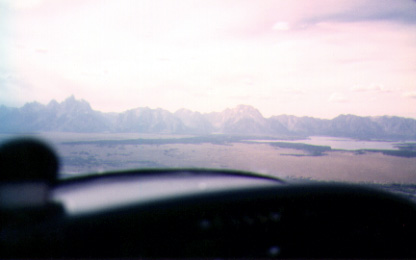
As you approach Jackson, the hills rise, and you start to see trees once again. Then, over a hill, you can finally see the Tetons, an absurd, sue-that-incompetent-doctor transplant of the Matterhorn and other pieces of the Alps into the hills of Wyoming. If it weren't so abominably cold in the winter, the entire world would move there.
The back side of the Tetons is not nearly as spectacular, and there's a wide valley that swings down to Pocatello and west to Boise. That's the safe way to get to McCall: follow the valley and then drive up from Boise. Do that, and you avoid all the mountains. It's also the most boring way, and takes you a hundred miles out of the way. But on such a trip, there's also a question of artistry. Like a skier choosing a line through the powder, you ask yourself which route you should take simply for beauty, the majesty of the mountains, the secrets of the valleys... across what part of this scenery do I draw my brush? I went over the mountains, a grotesque earthen corduroy that extends for hundreds of miles.
The peaks are around 10,000 feet, but you're supposed to get up to 14,000 for navigation reception. You follow your progress on the sectional map and note that the mountains are littered with airfields, but they're nearly impossible to find. They're all located at the bottom of deep gorges and accessible only by helicopters and 300 hp Super Cubs. Fat lot of good they'd do in an emergency.
McCall is located at the south shore of Payette Lake, a large glacial lake surrounded by evergreen-covered mountains. It's about 80 miles northwest of Ketchum, the old haunt of Ernest Hemingway and home of the famous Sun Valley resort. There's a lush valley extending south to Boise with trout streams and another, larger lake south of McCall.
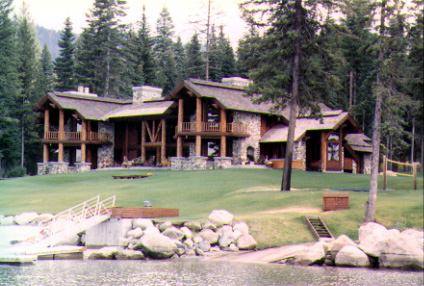
The McDonald's franchisee of Idaho put a big "M" in logs at the
front door.
It's a beautiful spot, and Jim and Judy Slaton moved there to escape the madness and crowds of southern California. "I don't miss California one bit," says Jim, as he shows you a photo of a brown bear cub that was climbing a tree in their yard two days before. Jim and Judy live in a log building backed up to a rushing stream that feeds out of the lake. When I arrived, the place was crawling with Falcophiles.
John and Pat Harns, Ben and Bernita Burgoyne, Dave and Barbara McMurray, Dan and Fran Martinelli, Larry and Ann Black, Richard and Catherine Clements, Cecil and Karen Rives, Ray and Sherry Purkiser, relatives, friends and a couple of intense possible Falco builders who were there to see for themselves. John and Midge Oliver made it as far as North Platte, Nebraska, where Midge announced that she had all she could take of the weather so they turned back. Per Burholm was trapped in San Diego with terrible weather and couldn't make it.
Throw all ideas of what a "fly-in" is out the window. These west coast Falco things are as much a weekend-long social event as anything else, with an occasional trip to the airport to get a hit on your habit, with us Falco-bimbos giving people rides and then basking in the praise of the newly-initiated. On Saturday morning, most of us went on a tour of the smoke jumper school, which was all the more relevant because a forest fire in the hills overlooking McCall was in the last stages of being extinguished. A couple hundred firemen were up fighting the blaze and all day long helicopters ferried water and people back and forth. And an assortment of oddball heavier aircraft lingered about the field and occasionally lumbered down the runway, barely clearing the hill at the end of the runway. A turboprop DC-3. An old DC-6 with a belly pod. An antique 4-engined, wrinkled-skin, empty-turreted eunuch of a bomber converted to water-bombing.
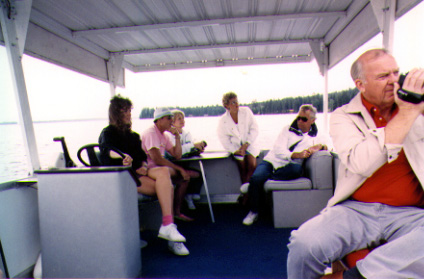
And after lunch we all went on a boat ride around the lake. McCall has a year-round population of only 2500 that moves in such a slow pace that when Jim Slaton called on a local lawyer, the receptionist who showed him into the man's office had to shoo his two dogs off the sofa so Jim could have a seat. But in the summer the population swells to 18,000 as the rich and famous of Boise and California escape the pace and heat of the real world and the SEC.
The lake is ringed by a surprising number and variety of homes, many so close together some neighbors share the same roll of toilet paper, but with prices of lakefront lots at $4,000 a front foot, you can understand why. The money that has been spent on some of the houses is astonishing-Jim said one of the houses on the lake cost fourteen million to build. I couldn't tell which one it might have been. The excessive opulence in log construction, golf-course-smooth lawns, helicopter pads, and swimming pools built right out into the lake rivaled the gaudiest that southern Florida has to offer. MacMansions for the Dan'l Trumps and Kitty Helmsleys of Idaho, and our tour guide told us how they all made their money.
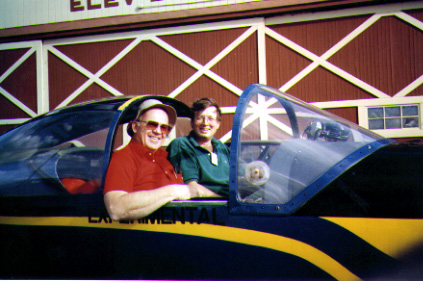
Cecil Rives gets his first ride in a Falco.
That night the faithful gathered for a banquet at the Shore Lodge, an evening of camaraderie and an opportunity for the modest ones among us to remind and congratulate ourselves that the quality of the airplane that brought us all together was exceeded only by the quality of the people interested in it, and damned if they were ever going to fool with Oshkosh again when they have this sort of get-together to take its place. Jim and Judy Slaton laid on a wonderful event for everyone. Next year John and Pat Harns will host the event at Coeur d'Alene, Idaho, on the weekend after Labor Day.
I headed back on Sunday. There was nasty weather to the east, so I flew down the valley and over to Pocatello. Gobs of clouds covered the mountains from Big Piney to Jackson, so I followed the road under the overcast down to Ogden, then scooted across the swale at Rock Springs and into Cheyenne. Then on to Des Moines, Iowa, and a short hop to Cedar Rapids where I bummed a bed off Ed and Karen Tripp and helped drink all their wine. The next day was an easy flight back home, with an hour on the gauges over the mountains again.
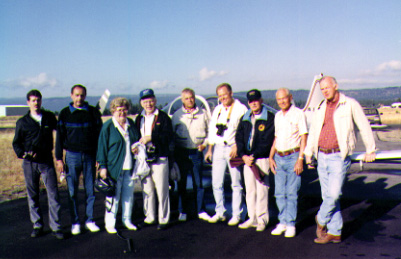
At McCall: Stuart Glemba, Gene Glenn, Bernita and Ben Burgoyne,
Richard Clements, Dave McMurray, John Harns, Jim Slaton and Cecil Rives.
The first thing I did when I got back was to rip my panel apart. When I first got the Falco some years ago, I had great plans for the panel. I had put post lights in the panel and had installed a turn and bank, but had never hooked them up. Then the radios were installed, and suddenly it was no longer easy to get all the pieces of the panel out-in fact, when I finally did it, I had to cut wires to get things out, such is the unbelievable chaos of the electrical system of my Falco.
But on the trip the airspeed indicator and altimeter remained with droplets of water on the inside of the glass. The DME wasn't working, and on the way into Cedar Rapids, I found myself unexpectedly caught by sundown, no lighting on the panel and with only one pathetic flashlight. It's stupid to get caught in a situation like that, and it's time to hook all that stuff up. Besides, a Sony GPS will fit perfectly in my Falco, and even if it doesn't have the database features of the better lorans, I like the idea of navigating direct to little airports I've had to search for-sometimes uncomfortably low on fuel-and having a navigation system that will continue to operate even in the event of total electrical failure.